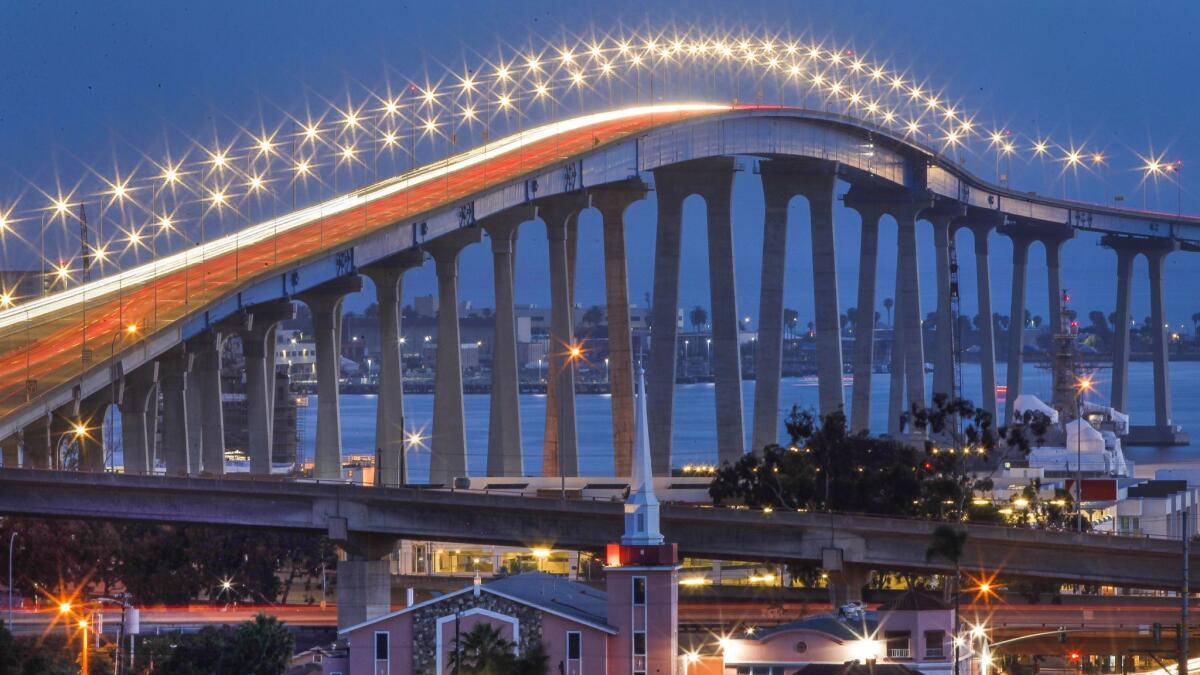To deter suicide attempts, bird spikes will be placed on San Diego-Coronado Bridge

- Share via
Reporting from San Diego — Under growing community and political pressure, Caltrans plans to install small spikes on the San Diego-Coronado Bridge as a temporary suicide deterrent while it pursues a permanent barrier.
The spikes, similar to those used to prevent pigeons from roosting on ledges and roofs, would sit atop the short wall that lines the bridge, where more than 400 people have jumped to their deaths since it opened in 1969.
Officials hope to have them installed within one year.
“I think it’s a start, and something is better than nothing,” said Wayne Strickland, a retired Coronado firefighter and president of the Bridge Collaborative for Suicide Prevention, a grass-roots group that has been leading the push for barriers. “The way it is now, it’s just too easy, and that’s why people go there.”
Caltrans announced the temporary measure as it released a final feasibility study this week that showed a barrier would be “suitable” for the bridge, which may soon surpass the Golden Gate Bridge in San Francisco as the nation’s deadliest span for suicides.
The yearlong study explored almost a dozen deterrent options, some patterned after barriers that have worked on other bridges.
They include mesh fences, glass panels and spike-like “thistles” that would be six to eight feet high, as well as a steel net, similar to what is being installed on the Golden Gate Bridge, that would sit about 20 feet below the roadway surface.
Caltrans will now narrow the choices, calculate the costs — the estimated price tag for the options ranges from $30 million to $137 million — and identify possible funding sources.
Add in the necessary environmental reviews and approvals from regulatory agencies and it could be five to 10 years before a permanent barrier is in place, said Ed Joyce, a Caltrans spokesman.
Many in Coronado are tired of waiting, and Caltrans acknowledged the “significant community concern” as it moved forward this week.
Dozens of times every year, the bridge is shut down as emergency crews try to stop someone from jumping, creating traffic snarls that in the past have lasted up to 12 hours, Coronado Mayor Richard Bailey said. On average, 83,000 cars cross the bridge daily.
“For many years, suicide has been a very taboo topic but we’ve finally made it through the threshold of having an open, honest conversation about it,” Bailey said.
Cost of the spikes would be about $100,000 to $300,000, said Joyce, adding that the height and type used haven’t been determined. The plan is to install them on the 7,400 feet of the bridge that crosses the bay.
The California Department of Transportation is counting on any visual, historical or other impacts to be minor enough to qualify the project for an exemption from full environmental review. They would be in place for no more than five years.
Wilkens writes for for the San Diego Union-Tribune.
More to Read
Sign up for Essential California
The most important California stories and recommendations in your inbox every morning.
You may occasionally receive promotional content from the Los Angeles Times.












![Vista, California-Apri 2, 2025-Hours after undergoing dental surgery a 9-year-old girl was found unresponsive in her home, officials are investigating what caused her death. On March 18, Silvanna Moreno was placed under anesthesia for a dental surgery at Dreamtime Dentistry, a dental facility that "strive[s] to be the premier office for sedation dentistry in Vitsa, CA. (Google Maps)](https://ca-times.brightspotcdn.com/dims4/default/07a58b2/2147483647/strip/true/crop/2016x1344+29+0/resize/840x560!/quality/75/?url=https%3A%2F%2Fcalifornia-times-brightspot.s3.amazonaws.com%2F78%2Ffd%2F9bbf9b62489fa209f9c67df2e472%2Fla-me-dreamtime-dentist-01.jpg)

